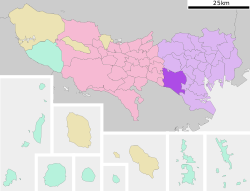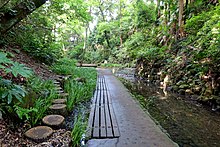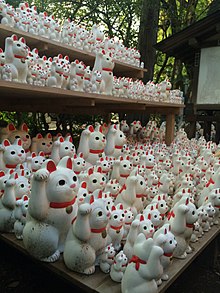Special ward in Tokyo, Japan
Special ward in Kantō, Japan
Setagaya (世田谷区, Setagaya-ku, officially called Setagaya City or the City of Setagaya) is a special ward in the Tokyo Metropolis in Japan. It is also the name of a neighborhood and administrative district within the ward. Its official bird is the azure-winged magpie, its flower is the fringed orchid, and its tree is the Zelkova serrata.
Setagaya has the largest population and second-largest area (after Ōta) of Tokyo's special wards. As of July 1, 2023, the ward has an estimated population of 940,071, and a population density of 16,194 persons per km² with the total area of 58.06 km².
Life expectancy
As of 2023, the life expectancy of Setagaya is 88.9.
Geography
Setagaya is located at the southwestern corner of the Tokyo's special wards and the Tama River separates the boundary between Tokyo Metropolis and Kanagawa Prefecture.
Residential population is among the highest in Tokyo as there are many residential neighbourhoods within Setagaya. Setagaya is served by various rail services providing frequent two- to three-minute headway rush-hour services to the busiest train terminals of Shinjuku and Shibuya as well as through service trains which continue travelling on to the Tokyo Metro lines providing direct access to the central commercial and business districts. Most rail lines run parallel from east to west and there are no north to south rail services within Setagaya, except for Setagaya Line light rail.
The ward is divided into five districts. These are Setagaya, Kitazawa, Tamagawa, Kinuta and Karasuyama. The main ward office and municipal assembly (city hall) is located in Setagaya District, but other districts also have their own branch ward offices as a part of the administrative structure. Each branch office provides almost identical services as the main office, but does not provide the services related to municipal assembly.
Most of the land is in the Musashino Tableland. The parts along the Tama River to the south are comparatively low-lying.
History
The special ward of Setagaya was founded on March 15, 1947.[citation needed]
During the Edo period, 42 villages occupied the area. With the abolition of the han system in 1871, the central and eastern portions became part of Tokyo Prefecture while the rest became part of Kanagawa Prefecture; in 1893, some areas were transferred to Tokyo Prefecture. With the establishment of Setagaya Ward (an ordinary ward) in the old Tokyo City in 1932, and further consolidation in 1936, Setagaya took its present boundaries.
During the 1964 Summer Olympics, the district of Karasuyama-machi in Setagaya was part of the athletics marathon and 50 km walk event.[1]
Politics
On April 25, 2011, amid national concern over the safety of nuclear power triggered by the March 11 earthquake and Fukushima I nuclear accidents, former Social Democratic Party House of Representatives legislator Nobuto Hosaka was elected mayor on an anti-nuclear platform.[2] Prior to becoming mayor, Hosaka was also well known for his staunch opposition of the death penalty[3] and his defense of Japan's Otaku culture.[4]















